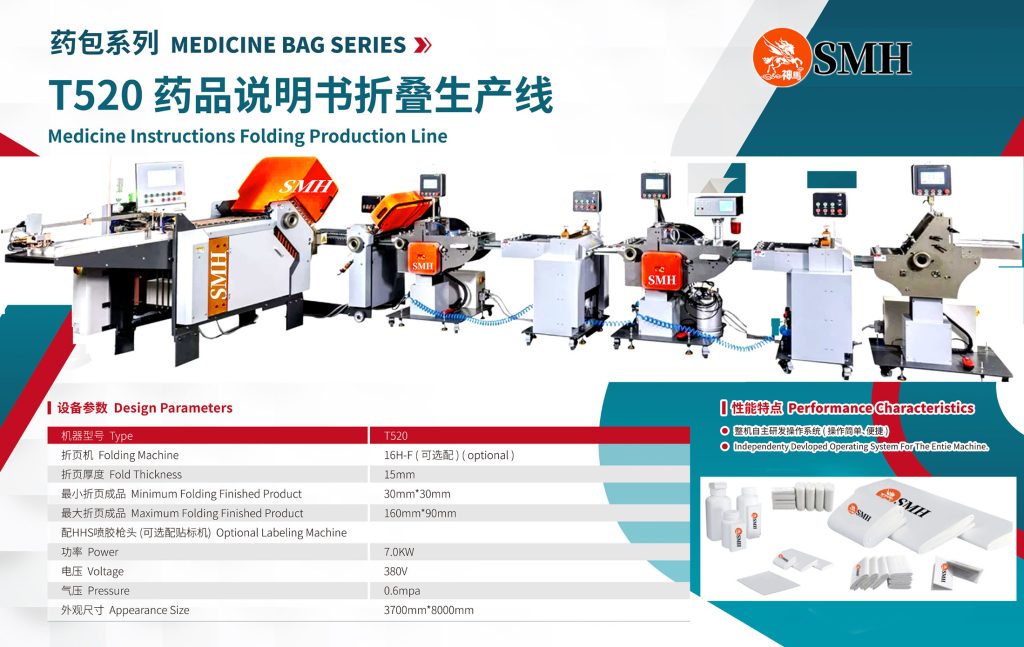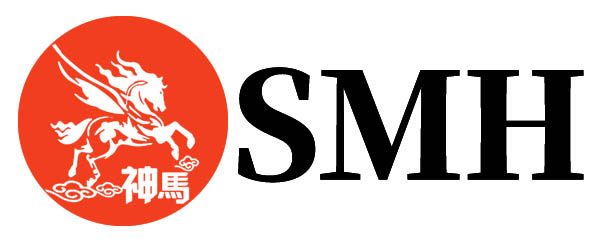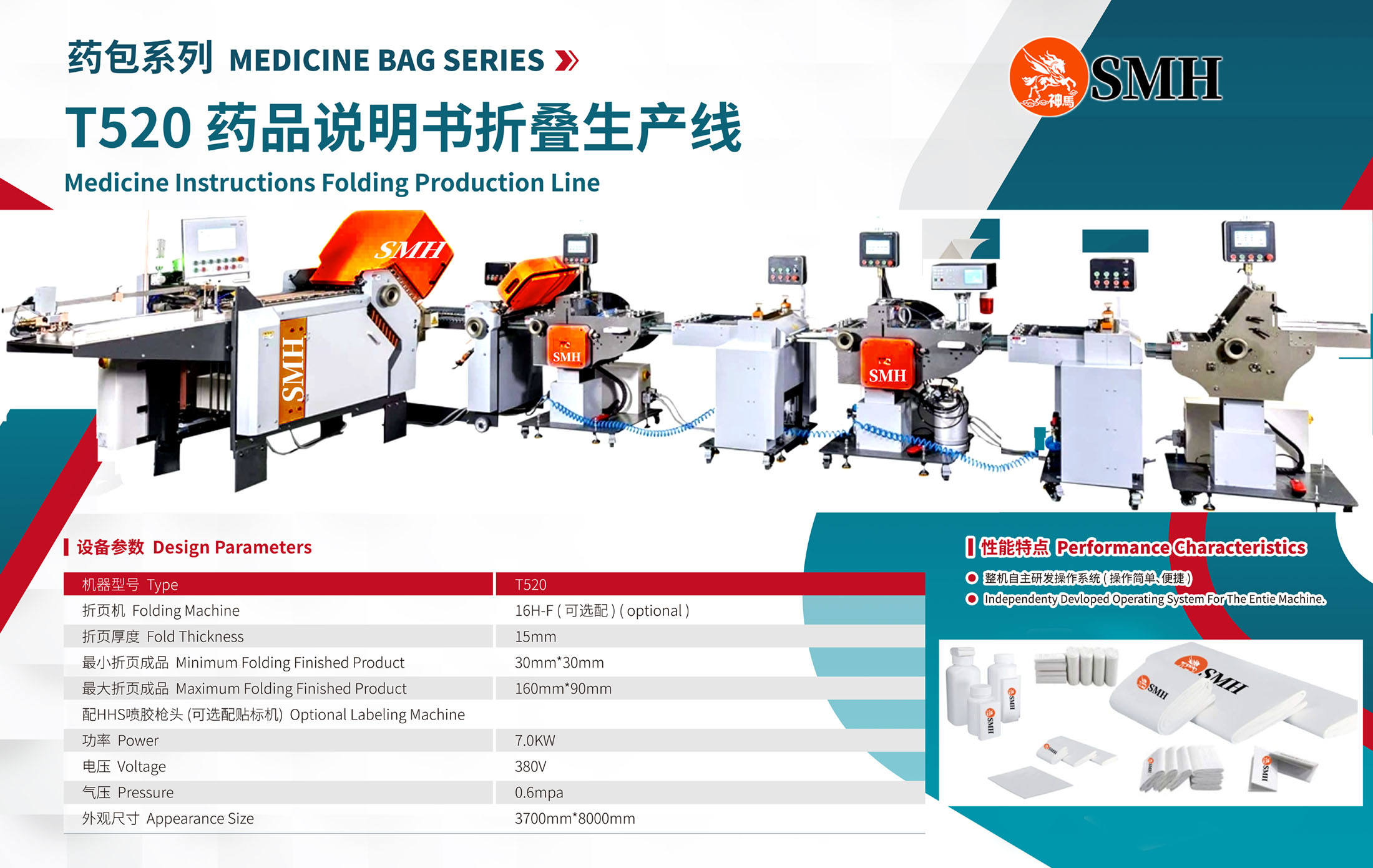The professional application of Combined Buckle and Knife Folding Machine in the folding of cancer drug instructions.

In today’s pharmaceutical industry, particularly in the field of oncology, drug instructions play a vital role in conveying essential information such as pharmacological data, medication guidance, side effect warnings, clinical trial results, and regulatory approvals. As cancer treatment methods continue to evolve—with the widespread use of advanced therapies like targeted drugs and immunotherapy—the complexity and volume of instruction content have significantly increased. These instructions often feature dense layouts, small fonts, and extensive details, making them challenging to handle. Typically, large sheets of paper must be folded into compact formats that fit neatly into medicine packaging. To ensure both readability and completeness, the folding process demands highly sophisticated equipment—capable of high precision, speed, adaptability to complex folding patterns, and the ability to prevent issues such as paper damage, misalignment, or rebound during operation.
The Combined Buckle and Knife Folding Machine is specifically designed to meet these demanding production requirements. By integrating two distinct folding techniques—traditional buckle folding and knife folding—it combines their respective strengths to deliver superior performance. This machine supports various folding styles, including parallel folding, cross folding, Z-folding, and core folding, making it especially suitable for applications requiring high folding accuracy and compact output, such as anti-cancer drug instructions.

Part I. Process Advantages
Enhanced flexibility and stability through combined folding structure
The buckle folding unit excels at performing continuous, high-speed parallel folds, while the knife folding unit specializes in precise angle control for operations like double folding and cross folding. By intelligently combining these two technologies, the machine can efficiently complete folding tasks for 8-page, 16-page, 32-page, or even 64-page documents. It enables the transformation of A3 or A2-sized instruction sheets into matchbox-like dimensions, meeting the need for compact yet comprehensive drug manuals.
Supports ultra-compact output ideal for small medicine packaging
Given the high cost, precise dosage, and strict storage conditions of cancer medications, their packaging is typically small and space-efficient. The final size of the instruction manual often needs to be less than 40mm × 30mm. This machine ensures accurate and delicate folding without damaging the paper, effectively addressing the challenge of “folding small into smaller”—a limitation of traditional folding machines.
Anti-static and dust-free design compliant with GMP standards
Cleanliness and static control are critical in pharmaceutical production environments, especially those handling anti-cancer drugs. This equipment features anti-static feeding components, a sealed dust-proof structure, and easy-to-clean rollers and blades, ensuring compliance with GMP cleanroom standards and minimizing the risk of contamination.

Part II. Typical Application Examples
Application One: Folding instructions for oral targeted therapy drugs
An international pharmaceutical company produces an oral targeted anti-cancer drug tablet measuring just 3×3 cm per pill. Its accompanying instruction manual contains 20 pages of multilingual (eight languages) information. Traditional folding machines often result in issues such as misaligned pages, blurred text, or oversized folds that don’t fit into the packaging. With this advanced machine, vertical segmentation is first achieved through three rounds of high-speed buckle folding, followed by precise horizontal folding using the dual-knife system. The resulting fold is neat, with sharp creases and aligned corners, fitting perfectly at the bottom of the bottle without requiring manual trimming—greatly improving production efficiency and yield.
Application Two: Integrated folding for injectable anti-cancer drug instructions
Injectable anti-cancer drugs are commonly available as powders or liquids, and their instructions must be automatically inserted into the packaging box along with the product. This requires high-speed, continuous production line integration. The machine seamlessly connects with automatic cartoning systems and includes an intelligent stacking module and anti-jamming feeding mechanism. This ensures that finished instruction booklets do not stick together, curl, or rebound, maintaining packaging consistency and visual appeal.
Part Iii. Highlights of Equipment Performance
High-speed output capacity: Up to a linear speed of 200 meters per minute or a folding capacity of 12,000 pages per minute, suitable for the rhythm of batch pharmaceutical production.
High-precision alignment system: It adopts a servo positioning and deviation correction system, with the folding deviation controlled within ±0.3mm.
Compatible with various paper materials: Whether it is light-coated paper, coated paper or 45g ultra-thin paper that is prone to wrinkling, it can operate stably without paper jams.
Modular structure design: The button-folding unit, knife-folding unit, automatic paper collection module, etc. can be freely combined and upgraded according to requirements.
Intelligent human-machine interface: Touch screen operation, featuring folding preset, job storage, automatic fault detection and remote maintenance functions.
Part Iv. Practical Value to Pharmaceutical Enterprises
Significantly improve production efficiency
The automated combination folding reduces manual operation and errors, ADAPTS to a 24-hour uninterrupted production mode, and increases production capacity by more than 30%.
Enhance the professionalism of packaging and brand image
Neatly folded, undamaged printed and precisely folded instruction manuals not only reflect the rigorous image of pharmaceutical enterprises, but also enhance the reading experience and trust of patients.
Save operating costs
By reducing the rework rate, lowering paper waste and minimizing manual intervention, the equipment can recoup its investment within 3 to 6 months.
Summary
In the SMH Folding application of cancer drug instructions, the Combined Buckle and Knife Folding Machine not only solves the industry problem of folding with high information volume and small volume, but also, with its high flexibility and precise control ability, It has provided reliable support for pharmaceutical enterprises in aspects such as information transmission, production compliance, and efficiency improvement. In the future, as regulations become stricter and the emphasis on user experience increases, devices with intelligent and combinable folding capabilities will become an important trend in the automated production of pharmaceutical packaging.


